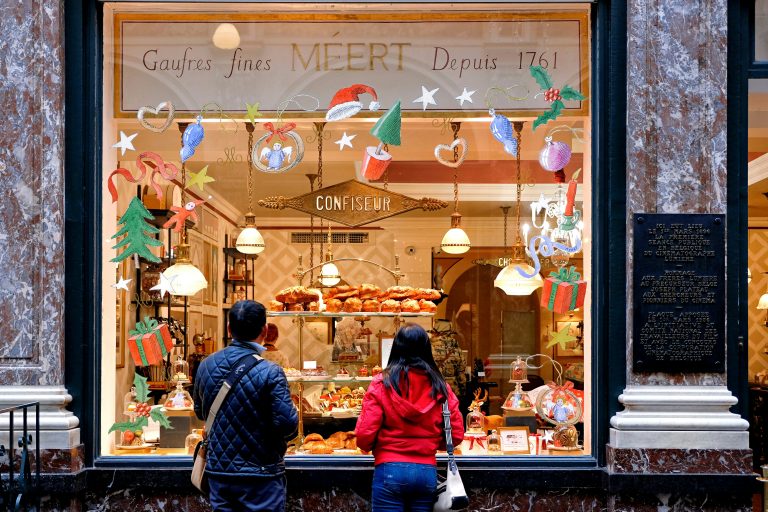It’s when night falls that Paris’ mysterious past reveals itself to those who know where to look 😉
From the Right Bank to the shores of the Left Bank, we set off on the trail of some of the capital’s scariest – yet now largely forgotten – legends: ghosts, abandoned graveyards, potions claiming to offer eternal life or divine forgiveness – we’re going to take you to see the dark side of the city of lights!
Starting point: Vélib’ station n°1018 (Alger-Rivoli)
Finishing point: Vélib’ station n°6001 (Institut de France)
Journey time: 2 hours

The ‘red man’ of the Tuileries

Gravure de l’incendie des Tuileries, 1874. Archives nationales ©Public domain, via Wikimedia Commons
Ghostbusters fans will be delighted: we’ve barely broken into a sweat when we’re already hot on the heels of a phantom – and not just any phantom – one which haunted the corridors of the former royal palace, the Palais des Tuileries!
We should probably warn you that this is not for the faint-hearted 👻 👻!
The legend tells of the ghost of a man dressed in red, who went by the gloomy name of Jean l’Écorcheur (John the flayer), who appeared to the palace’s inhabitants by night, just before disaster of some kind struck.
This curse goes back to the time of the famous Catherine de’ Medici: Jean the flayer, a butcher by trade working in an abattoir (which was called a ‘slaughter’ (tuerie) back in those days) near to the palace, was supposedly murdered by Neuville, one of the Queen’s spies. Why? The butcher knew rather too many court secrets…As he breathed his last, Jean swore that they’d see him again.
Since then, several famous occupants of the palace have claimed to have seen his bloody figure in the corridors of the royal residence, including Marie-Antoinette and Napoleon, to name just a few.
Lost without trace in rue Courtalon

©jean louis mazieres on VisualHunt.com / CC BY-NC-SA
We’ve only just got our breath back on rue de Rivoli when we glimpse the narrow entrance to rue Courtalon. We can almost feel the hairs on the backs of our necks stand up as we prepare to listen to the macabre tale associated with this street.
Although now largely forgotten, this real-life crime story was headline news back in 1684, when large numbers of people started to go missing. In the space of a few months, no fewer than 26 young men disappeared. The rumour mill got underway and worried Parisians started calling for something to be done.
To put the public’s mind at rest, superintendent La Reynie (the city’s first chief of police) tasked one of his staff, Lecoq, to shine a light on this sordid affair. Lecoq uncovered a highly elaborate human body parts trafficking scheme: a young woman claiming to be a princess looking for a suitable match lured young men into an apartment on rue Courtalon, where, after having turned their heads, she got her team to take them right off! The heads, separated from their bodies, were sold to German students and the rest of the corpse to medical students. It’s really a story to give you shivers up your spine!
The cemetery of the Saints-Innocents

Cimetière des Innocents de Paris, gravure sur bois ©Wellcome V0042399
A few hundred metres from here is the Fontaine des Innocents, lost in a sea of shops, restaurants and fast-food outlets beside Les Halles. In times gone by, the main residents were a little less lively…a church was located at this spot, and where you have a church, you have a graveyard!
The grisly schedule of burials in this graveyard was carried out at such a frenetic pace that eventually, the ground could no longer take all the bodies being interred here. Workers were suffocating because of the accumulation of noxious gases released whenever there was building work going on at basement level in the area. The cemetery was already in use at the time of the Merovingians, so that its level was more than 2 metres higher than the adjoining streets. However, it wasn’t until the cellar walls of a local restaurant collapsed in 1780, decanting a wave of corpses, that the cemetery was finally closed down and emptied over the course of the following years. The bones were dumped in the quarries at Montparnasse and the Barrière d’Enfer. In the 19th century, this became the Paris Catacombs.
Nicolas Flamel and the philosopher’s stone

L’Alchimiste, David Ryckaert III, ©Museo del Prado Public domain, via Wikimedia Commons
Head to 51 rue de Montmorency and stand in front of the fine house of one of France’s most mysterious figures, who was thrust into the limelight again a few years ago thanks to the adventures of a famous English wizard. Have you guessed who we’re talking about yet? The famous Nicolas Flamel, of course!
Having lived in the 14th and 15th centuries, his fame is partially due to his considerable fortune, which generated much envy – and many questions.
Flamel was a scribe, but rumour had it that by night he put on his alchemist’s hat. This branch of natural philosophy was particularly prominent during the Middle Ages and focused on two main goals – creating an elixir of immortality and the philosopher’s stone, which would enable base metals to be turned into gold. Legend has it that Nicolas Flamel, thanks in part to an ancient book of Egyptian magic translated into Latin, managed to change the composition of base metals using his philosopher’s stone (Rowling’s inspiration), as well as creating the elixir of immortality…
Maybe you’re starting to regret not having paid more attention in Latin class now, hmm?
N.B. History-lovers will be interested to know that this house, built in 1407, is considered to be the oldest in Paris!
The blood-soaked place de Grève

Hôtel de Ville de Paris et la place de grêve sous le règne de Henri IV. D’après le dessin de Claude Chastillon, gravure de Matthäus Merian, Boisseau 1645 ©Public domain, via Wikimedia Commons
So, we’ve arrived in front of the Place de l’Hôtel-de-Ville – Esplanade de la libération, which used to be called Place de Grève. Before it was paved over, it was a shingle beach (‘grève’ in French – our descendants tended to call a spade a spade!), where goods arriving via the River Seine were unloaded.
Because there was so much going on here, it was an ideal place to find work and thus became the place to go for anyone looking for a job. It’s strange to think that today, the French expression ‘être en grève’, now ‘faire grève’ has evolved from meaning precisely the opposite of what it once meant – a collective downing of tools J
Still, the square continues to bustle with activity, mostly from a wide variety of cultural events (fairs, concerts, exhibitions etc). In bygone times, the entertainment was rather more deadly, with public executions being the most popular show in town! For example, it was here that Ravaillac (the assassin of King Henri IV) was drawn and quartered before finally dying after many hours of torment.
As the saying goes, other times, other customs.
The legend of the church of Saint Julien-le-Pauvre

Saint-Julien transportant Jésus sur l’eau ©Wellcome
Let’s cross the Ile de la Cité, where our love of tales of the unexpected leads us further afield.
Under the shade of Paris’ oldest tree (a black locust tree dating from 1601!) we find one of the city’s oldest churches (its construction was begun at the same time as that of Notre-Dame, but it was finished much more quickly) the church of Saint-Julien-le-Pauvre. A real gem of medieval architecture, it derived its name from the adjoining hospice, which was under the protection of Saint Julian the Hospitaller, patron saint of innkeepers and ferrymen and women.
But who was he really? This story is steeped in legend and was particularly popular during the Middle Ages, the reason for which will soon become apparent. Like many young noblemen of his time, Julian spent most of his time hunting. One day, when he was chasing a deer, the latter predicted that he would kill his father and mother. Wanting to escape from this deadly destiny, Julian left for another country and made himself a new life there. While he was away hunting, his wife welcomed his parents into his house – they not having abandoned efforts to find him – and suggested they rest a while in the bedroom. Seeing a man and a woman in his bed, Julian, furious with rage, killed them both, thinking that it was his wife and a lover. When his wife returned from mass, he realized his mistake and set off to do penance. He gave up his castle and his worldly goods to become a ferryman, living by the riverside, where he opened his house to poor people. One evening, a leper came to him. He was so frozen that Julian watched over him all night long and let him sleep in his bed so he could stay warm. At this moment, the leper revealed himself to be an angel, who told him that God had forgiven him for his crimes.
What a strange fate, with a touch of the oedipal about it!
The charnel houses of the church of Saint-Séverin

Gargouille de l’église Saint-Séverin à Paris, ©Roman Bonnefoy
Heading back towards the Latin Quarter, we pass the church of Saint-Séverin with its pretty little garden surrounded by gothic-style alcoves. These strange ‘arcades’ are not the remains of a cloister, as you might well think. In fact, they are the remnants of a medieval charnel house dating from at least as early as the 15th century (graves dating from the Capetian period have been found here). These galleries once housed the tombs of rich Parisian aristocrats, whereas the less well-off were buried in the central area in a mass grave.
As well as housing one of the oldest bells in Paris (la Macée), the cemetery of the church of Saint-Séverin was where the first surgical procedure for the removal of a kidney stone was carried out. Who was the lucky guinea pig for this operation, I hear you say? A man sentenced to death, who was pardoned after the successful operation. He was still made to suffer, however, given that anaesthetics were unknown at that time. It was a bit of a gamble, but one that probably seemed worthwhile!
The cursed seat

Pont des arts, Académie française, ©Richard Cohen
Our itinerary is almost over, and it’s time to drop our Vélibs off – but not before sharing one last amusing anecdote, and, as luck would have it, we’re right in front of the Académie Française, which apparently is under a terrible curse…
It all began in 1911, when Gaston Leroux’s novel Le Fauteuil Hanté, (the haunted seat) recounted the story of a seat at the Académie française which was always empty. It remained empty because as soon as someone was elected to that particular seat, they would, without exception, die in mysterious circumstances before being able to claim their place.
Is this just a case of a writer with a particularly fertile imagination? Not necessarily. Events surrounding seat number n°32 would seem to bear a curious resemblance to this story…Several ‘Immortals’ (members of the French Academy) connected with this seat have breathed their last in strange circumstances. Louis-Simon Auger, the first to sit in this seat in the new French academy, had a tragic end when his body was recovered from the River Seine in 1829. Robert Aron died in 1975, just 5 days after his swearing into the Academy. His successor, Maurice Rheims died in 2003 and it would be 8 years before the person who picked up the torch from him gave their inaugural address, as dictated by tradition. In fact, the first person who was elected to succeed him, Alain Robbe-Grillet, never took up his seat at the Academy, so it wasn’t until François Weyergans was sworn in that Maurice Rheims finally received the send-off he deserved.
The latter died a little over one year ago – can we safely say the curse has finally been laid to rest? Only time will tell…




